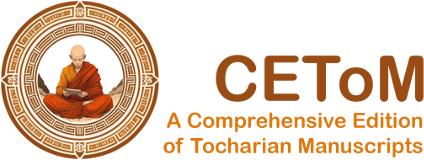Work in progress
PK AS 19.11
| Known as: | PK AS 19.11; Pelliot Koutchéen Ancienne Série 19.11 (number in 1982) |
|---|
| Cite this page as: | Georges-Jean Pinault; Hannes A. Fellner (collaborator). "PK AS 19.11". In A Comprehensive Edition of Tocharian Manuscripts (CEToM). Created and maintained by Melanie Malzahn, Martin Braun, Hannes A. Fellner, and Bernhard Koller. https://cetom.univie.ac.at/?m-pkas1911 (accessed 02 Jul. 2025). |
|---|
Edition |
| Editor: | Georges-Jean Pinault; Hannes A. Fellner (collaborator) |
|---|
| Date of online publication: | 2014-07 |
|---|
Provenience |
| Expedition code: | M 504 (provisional number 764) |
|---|
| Collection: | Bibliothèque nationale de France, fonds Pelliot Koutchéen (Paris) |
|---|
Language and Script |
| Language: | TB |
|---|
| Linguistic stage: | classical |
|---|
| Script: | classical |
|---|
Text contents |
| Title of the work: | Pratītyasamutpāda |
|---|
| Text genre: | Literary |
|---|
| Text subgenre: | Abhidharma |
|---|
| Verse/Prose: | prose |
|---|
Object |
| Manuscript: | PK AS 19 |
|---|
| Material: |
ink
on paper |
|---|
| Form: | Poṭhī |
|---|
| Size (h × w): | 5.4 × 9.9 cm |
|---|
| Number of lines: | 4-5 |
|---|
| Interline spacing: | 1.2 cm |
|---|
Images
Transliteration
| a1 | /// – – – [na] – – – – – – – – /// |
|---|
| a2 | /// e – [p]r· – – e ka ñ· ññ[e] /// |
|---|
| a3 | /// ska – – ○ /// |
|---|
| a4 | /// [l](·) skeṃ [s]kwa [ss]· – – ·e /// |
|---|
| b2 | /// tu meṃ pa ñä k[te] – /// |
|---|
| b3 | /// [•] tu meṃ pa ñä ○ /// |
|---|
| b4 | /// ye ta rka naṃ [ck]e nta re skeṃ lym· /// |
|---|
| b5 | /// ·ä ·ā p· [ma] ska [s]· – – a [st]ā /// |
|---|
Transcription
Translation
| a2 | ... possession ... |
|---|
| a4 | ... they go out, happy ... |
|---|
| b2 | ... Thereupon the Buddha-lord ... |
|---|
| b3 | ... Thereupon the Buddha-lord ... |
|---|
| b4 | ... they emit ... the rivers flow into the lakes ... |
|---|
| b5 | ... of the bones ... |
|---|
Commentary
Remarks
| * | The fragments of the PK AS 19 series (19.1-19.22) all belong to the same manuscript. This little fragment is the left side of a leaf including the string hole in line 3. Recto and verso cannot be identified. Some of the lines show remnants of akṣaras from another leaf. |
|---|
Philological commentary
| n1 | There seems to be form of the verb mäsk- 'to exchange' attested in this line, but it can not be identified with absolute certainty. |
|---|




